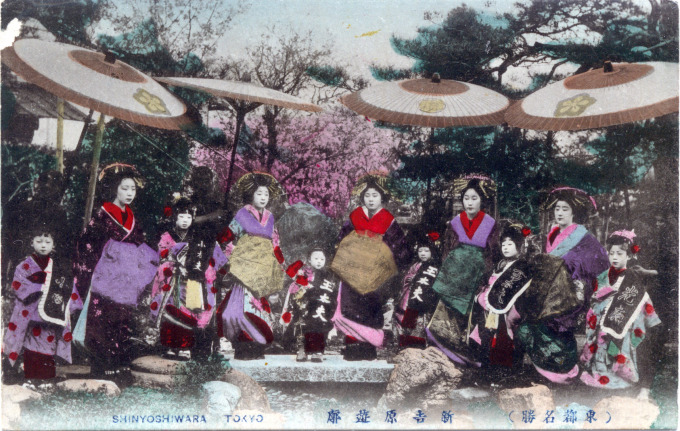See also:
Yoshiwara (Tokyo)
“A procession of oiran at Yoshiwara”, c. 1920.
“… When a young girl was brought to a brothel as a Kamuro, it was usual for the keeper of the house to see and name her. In the selection of these names high flown cognomens such as were bestowed on courtesans were carefully avoided. and pretty innocent names were chosen. These names rarely exceeded three syllables and never four in any case.
“The courtesan to whom the Kamuro belonged was called her ane joro and this ane joro found the Kamuro in clothes and paid all other expenses in connection with the child. The keeper of the brothel watched the behaviour and disposition of all the Kamuro in his houses, and if any promised to become famous courtesans he had them instructed in every branch of deportment and taught the banjo (samisen), harp (koto), floral arrangement (ikebana), incense burning (senko), tea ceremonial (cha no yu), and other accomplishments which were considered necessary in aspirants for the profession.
“The behaviour of Kamuro towards their ane-joro was generally gentle and submissive and they waited on her most assiduously They attended to all her wants, waited on her at meals, lit her pipe when she desired to smoke, accompanied her when she promenaded in the Naka no cho, and ran all her errands in the neighbourhood. The Kamuro would also perform trifling services for the guests of her ane joro such as bringing water for washing their hands, etc.
“It was the custom originally that no Kamuro should assist at a wine party as she was expected to remain sitting by the side of her mistress in the same manner as the page of a feudal lord sat behind his master, but later on this custom was changed and now the Kamuro wait on guests and pour out the sake. When there was no available ane joro, the Kamuro used to wait on the master of the house, and if the latter found her smart beautiful and likely to become a popular courtesan, he took her himself as a sort of adopted daughter and had her educated at his own expense so as to fit her for the calling.”
– The Nightless City: Or, The History of the Yoshiwara Yūkwaku, by Joseph Ernest De Becker, 1899



Pingback: Yoshiwara (Tokyo) | Old Tokyo
Pingback: Three ‘shikomi’ (maid apprentices), c. 1910. | Old Tokyo
Pingback: “Kyoto Tayū dochu”. Procession of tayū and kamuro through the “flower town” (hanamichi), Kyoto, c. 1920. | Old TokyoOld Tokyo